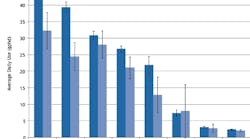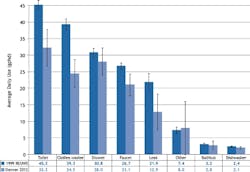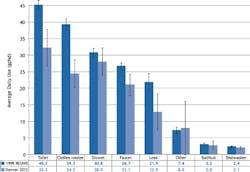DENVER — Water … It is one of our most precious natural resources. This past summer, more than 75% of the U.S. faced near-drought conditions. Water was top of mind for most Americans — for residential use, irrigation purposes and energy production. Water conservation is becoming part of the social consciousness, from using less water to installing high-efficiency plumbing fixtures.
The industry, collectively, works diligently toward water conservation through education, awareness and new technology, and organizations, manufacturers and contractors alike are on the forefront of bringing water saving innovation and awareness to the end user.
The Water Research Foundation (WRF) is one such organization bringing residential water usage behavior to the forefront. In 1999, the Water Research Foundation published the Residential End Uses of Water Study (REUWS) conducted by a team lead by Aquacraft, a water-engineering firm focused on improving urban water management based in Boulder, Colo.
The research has been used widely to understand how and where water is used in residential settings across North America. A sample of approximately 1,200 were chosen at random from a highly detailed water use analysis, using a combination of billing analyses, surveys and data logging customer meters. The project and subsequent study was so popular that, in 2011, the Foundation developed a plan to update and expand upon earlier findings, which led to the funding of project #4309, “Update and Expand Residential End Uses of Water.”
Preliminary results from the research project to “Update and Expand the Residential End Uses of Water” study have been released by the Water Research Foundation and can be found in Drinking Water Research magazine, July-September 2012. This project is being conducted by a research team lead by Bill DeOreo, president of Aquacraft Inc., and Peter Mayer, vice president of Aquacraft Inc. Below are a couple graphs from the study.
Source: DeOreo, B., and P. Mayer, Residential End Uses of Water: Progress and Interim Results. Drinking Water Research 22(3):14-22. Copyright 2012 Water Research Foundation. Reprinted with permission.
Comparison of Average Annual Water (kgal) Use From Single-Family Homes Among Study Sites
Comparison of Denver’s 2012 Indoor end uses of water to 1999 REUWS sample
Project 4309
The purpose of the new project is to select a new sample of 1,400 single-family homes across the United States and Canada and to obtain new flow trace data that can be compared to the original data. The goal of this project is to update and expand the 1999 Residential End Uses of Water Study (REUWS). Aquacraft and its team will collect new data and build upon the 1999 REUWS and other similar end-use studies conducted since 1999 to obtain detailed information on where water is used in single-family residences in North America and to evaluate the socio-economic factors that impact water use. This project kicked off in mid-2011 and scheduled to be completed by late 2013.
“We hope that the current study adds to the growing body of knowledge about residential water use and demand patterns and contributes to advancing the science of water demand management,” said Peter Mayer of Aquacraft. “The update will evaluate changes in water using fixtures and performance, as well as behavior patterns, and will help inform future water planning and conservation program efforts.”
Since the initial REUWS data was collected in 1999, there has been speculation that residential water usage is declining despite increasing household sizes and occupancy. In the intervening years since the 1999 study, research shows that significant changes to plumbing fixtures and appliances have occurred, and per household water use nationwide has decreased. Some reasons for the decrease in indoor water use were driven mainly by high-efficiency toilets and clothes washers, and in reductions in leakage rates.
“Aquacraft's end use research over the past 15 years has documented significant changes in the water efficiency level of toilets, clothes washers, and faucets in the residential setting due to technological changes,” said Mayer. “There is clear evidence that technological efficiency improvements have impacted water use and have contributed substantial to reductions in water use observed nationwide. At the same time, Aquacraft has found that some behaviors such as toilet flushing frequency and the frequency of running a clothes washer have not changed much. We will be paying close attention to behavior patterns related to showering and faucet use as part of the Update study to try and examine the interplay between changing technology and behavior.”
The current study to Update the Residential End Uses of Water will provide a new benchmark of residential water use that will be used to understand how things have changed and where we are heading in the future.
Furthermore, the overall objective is to comprehensively update the WaterRF 1999 Residential End Uses of Water report. The update will expand the end-use datasets and include socioeconomic analyses on the datasets, so that the final research report can be used in demand forecasting, planning and conservation programming. This project will focus solely on single-family residences.
Research partners and co-funding organizations include: Alliance for Water Efficiency, City of Fort Collins, City of Scottsdale, Clayton County Water Authority, Denver Water, Portland Water Bureau, Region of Peel, Region of Waterloo, San Antonio Water System, Tacoma Public Utilities, Tampa Bay Water Authority and Toho Water Authority.
“We wanted to include as many cities from diverse regions of North America as possible,” said Mayer. “Cities volunteered to participate in this study. Level 1 participants contributed funding to the project. Level 2 participants contributed in-kind services and data. We worked hard to recruit cities from across the United States and Canada to participate in the research. We recognize the limitations of this approach, but we are pleased that this study includes water providers from many different regions in the U.S. and Canada.”
The end goal is to understand very specifically how much water is used in the average North American household. The goal is to quantify how many gallons are consumed by toilets, faucets, showers, dishwashers, clothes washers and outdoor irrigation.
“Installing modern plumbing and irrigation equipment over the past decade has made an enormous difference in household water use,” said May Ann Dickinson, president and CEO the Alliance for Water Efficiency (AWE). “We expect the study to identify how much household water use may be actually declining, and hopefully also how much of it is due to lower fixture volumes rather than consumer behavior. That will be an important outcome of the study.”
Outdoor irrigation, for example, is a big component of residential water use, and climate is a significant factor in determining irrigation requirement levels. In warm climates with low precipitation rates, outdoor water use tends to be higher than in cooler climates or those that receive more precipitation. Landscape choices, irrigation method, and household income are also factors that have been shown to influence outdoor water use.
“Indoor water use tends to be less discretionary than outdoor use and as a result less likely to be influenced by price,” said Mayer. “People must flush, shower, cook, and wash clothes and the cost of the water used to do these essential tasks may influence purchasing decisions for fixtures and appliances, but has less impact on the actual decision to use water or not. Outdoor water use is more variable and is more likely to be impacted by changes in the cost of water, particularly for households on a tight budget.”
Inside the numbers — Denver
A snapshot of early findings of the ongoing study finds that end uses of 2012 Denver homes were substantially lower than the 1999 REUWS sample in most categories, especially in toilet and clothes washer use. It is believed that this includes a combination of wider adoption of high-efficiency fixtures and appliances, as well as a heightened awareness of the importance of conservation by customers in response to drought conditions and Denver Water’s “Use Only What You Need” water efficiency campaign.
In Denver, 34% of the study homes had an average toilet flush volume less than two gallons per flush (gpf), indicating they are largely equipped with ULF or HE toilets. Meanwhile, 26% of the homes had no flushes in the low volume range. The remaining 40% of the homes had a mixture of low volume and older high volume toilets. Flushing frequency has not changed much over the nearly 20 years Aquacraft has been researching residential end uses.
In Denver, there was an average of 12 toilet flushes per household per day. Homes equipped with lower volume toilets did not flush more frequently than homes equipped with higher volume toilets. The average toilet flush volume was 2.63-gpf. This is the third time end use data has been collected from a representative random sample in Denver and there has been a steady decline in the average toilet flush volume as older fixtures have been replaced. The results show progress in flushing efficiency, but also indicate that conservation potential remains in the toilet category. In 2012, 20% of the toilet flushes in Denver exceeded 3.5-gpf.
“This probably is the most important study that we can do,” said Dickinson. “Unless we all collectively have a good understanding of how water is actually used in this country, we will not be able to design appropriate solutions for fostering sustainable water use. We last looked at how water is used in the home back in 1999. A lot about water use has changed since then, and this study will be an important part of understanding that change. The Alliance for Water Efficiency has a Home Water Works website and water-use calculator, and we are very interested in ensuring that our calculator uses the most up-to-date information available if we are to advise homeowners on their water usage.”




